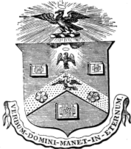Ludgate Hill
Hills of LondonLandforms of the City of LondonStreets in the City of LondonUse British English from November 2014

Ludgate Hill is a hill in the City of London, near the old Ludgate, a gate to the City that was taken down, with its attached gaol, in 1760. It is the site of St Paul's Cathedral, traditionally said to have been the site of a Roman temple of the goddess Diana. It is one of the three ancient hills of London, the others being Tower Hill and Cornhill. The highest point is just north of St Paul's, at 17.6 metres (58 ft) above sea level.Ludgate Hill is also the name of a street which runs between St Paul's Churchyard and Ludgate Circus (built in 1864), from where it becomes Fleet Street. It was formerly a much narrower street called Ludgate Street.
Excerpt from the Wikipedia article Ludgate Hill (License: CC BY-SA 3.0, Authors, Images).Ludgate Hill
Ludgate Hill, City of London
Geographical coordinates (GPS) Address Nearby Places Show on map
Geographical coordinates (GPS)
| Latitude | Longitude |
|---|---|
| N 51.5137 ° | E -0.101 ° |
Address
McDonald's
Ludgate Hill 1A
EC4M 7AA City of London
England, United Kingdom
Open on Google Maps










